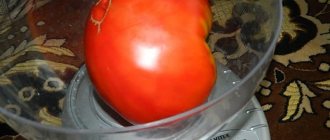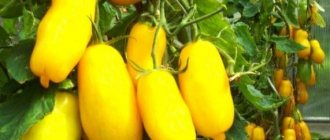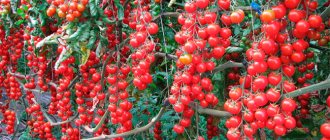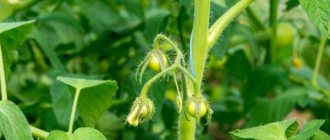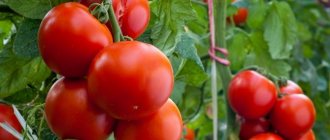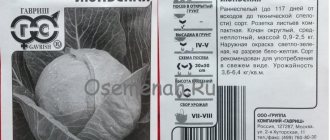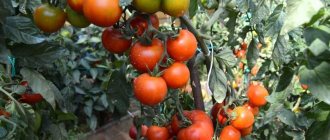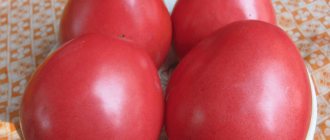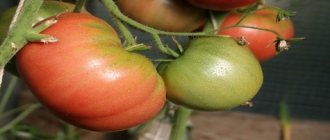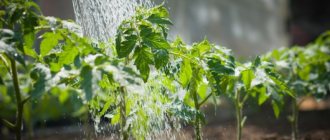Appearance of tomatoes
Any variety of Konigsberg tomato looks very impressive: the shape of the fruit is not the classic “tomato”, it resembles either an eggplant or a large plum, but in any case, the appearance of a ripe tomato evokes a strong desire to try it as soon as possible.
The appetizing nature of the fruits of Koenigsberg is undeniable, and this feeling is not deceiving
The bushes, when formed correctly, do not look gigantic, but resemble a kind of tomato tree, densely hung with large fruits of varying degrees of ripening.
Konigsberg fruits grow in clusters of several pieces
Koenigsberg tomatoes on video
If you grew Koenigsberg tomatoes, please write whether you liked them or not? What was the yield and taste of the fruit? Will you grow them again? How do you rate the disease resistance of this variety? Briefly describe the advantages and disadvantages of this tomato in your opinion, evaluate its taste. If possible, attach to the comment a photo of the entire bush as a whole or individual fruits that you grew. Thank you!
Your reviews of the Koenigsberg tomato and additions to the description will help many gardeners evaluate this variety more objectively and decide whether it is worth planting or not.
This is a natural variety of tomato. Therefore, we recommend taking seeds from a ripe fruit and using them for planting in subsequent seasons.
Advantages and disadvantages of Koenigsberg, differences from other varieties
The Koenigsberg tomato is truly special, although, of course, in appearance it can be confused with some others: after all, there are now a huge number of varieties and hybrids. So, for example, the shape of the fruits of the fairly new early-ripening tomato Kaspar 2 is very similar to it, but in Koenigsberg they are 2–3 times larger. The same applies to the fruits of the Emperor tomato, but the taste of the latter is rated only as good.
A special feature of the Koenigsberg variety is that it has virtually no disadvantages. Relative disadvantages are sometimes cited as the fact that the crop does not ripen very early, and that most fruits do not fit into standard canning jars. But for pickling, there are many other varieties specially created for this purpose! This is both the good old Newbie and the no less well-deserved Novelty of Transnistria...
The most important advantages of the Koenigsberg tomato variety are:
- high adaptive abilities, allowing to grow and bear fruit in any climate;
- increased resistance to most diseases;
- beautiful appearance of tomatoes;
- very high yield, almost independent of whether the tomato is grown in open ground or in a greenhouse;
- drought resistance, up to heat resistance;
- excellent fruit taste and bright aroma;
- a variety of colors within one variety, allowing you to find an admirer “for every taste and color.”
Despite the fact that the ripening period for Koenigsberg is not early, the crop manages to ripen even in a short summer, and unripe tomatoes “reach” normally during storage. It has been proven that the chemical composition of fruits is very diverse; they contain an increased content of especially useful substances and microelements, compared to many varieties.
The fact that the variety is not afraid of either drought or heavy rains allows us to recommend it for cultivation in any conditions, including beginning gardeners. True, to obtain maximum yields they will have to learn a little, but Koenigsberg will produce quite a decent amount of tasty fruits with minimal care.
As soon as the Golden Koenigsberg appeared, I managed to try planting it on my site. The very next year, even Persimmon was removed from the arsenal, since it seemed that among the yellow-fruited tomatoes there were no better options yet. The red subspecies is not so original, the rest somehow did not take root, but the golden variety is planted annually in the amount of a couple of dozen bushes and has never failed.
Features of care
The Koenigsberg tomato resists weather changes and attacks from fungi and pests well. In general, the variety is not capricious. But there are nuances of care.
There is no need to water the first ten days after transplanting to a permanent location. This will give the roots the opportunity to adapt to new conditions, adapt, and strengthen.
Then you should water it well and feed it after five days. Then you will need to fertilize every two weeks. It is best to use the following solutions for this:
- matchbox of urea onto a bucket of water. Water half a liter under a young plant and one liter under an adult bush;
- Dissolve a half-liter jar of wood ash in a bucket of water. Water half a liter for young bushes, one liter for adults;
- Fill the barrel a third with weeds, add water when it ferments and use it for feeding. You can pour 200 ml under each bush and then water it, or you can immediately dissolve a liter of water in a bucket and water it with ready-made fertilizer.
Regular preventive maintenance work to protect against pests is mandatory. It is not at all necessary to use chemicals for this. It is enough to regularly spray the plantings with steep onion broth or simply spread onion peels along the beds.
Watering should be done 1-2 times a week, not more often. Under one bush you need to pour at least a bucket of water at a time, but gradually, so that the moisture has time to be absorbed.
Mulching should be done regularly to prevent the soil from drying out.
Koenigsberg should be formed into two stems. To do this, a stepson is left above the first formed ovary, and all the others are removed every 10-14 days.
Important! In extreme heat and in greenhouses, to increase productivity, you need to pollinate the tomato yourself.
Area of application of fruits
All subspecies of this tomato have a wonderful taste and rich tomato aroma, so their purpose is universal. Tomatoes are eaten fresh, added to summer salads and snacks, and also used for preservation. And if for whole-fruit canning only some of the subspecies are used - with the smallest fruits, then for the preparation of tomato paste, juice or ketchup you can use any tomato fruits from the Koenigsberg series.
Related article:
We sow tomatoes. 3 components of healthy seedlings
Varieties
Koenigsberg gold
In this subspecies, the bushes grow not up to two meters, but up to one and a half. The fruits are elongated, bright yellow-orange. The first of them weigh 450-500 g, and those that appear in the upper clusters weigh up to 250 g. The pulp is dense, sweet, it contains a lot of juice, but few seeds.
Koenigsberg heart-shaped
The fruits are pink-crimson, the largest of all varieties of the variety - they can weigh up to a kilogram. The pulp is fleshy, sweet, suitable for processing and other culinary purposes.
Koenigsberg pink (aka New Pink)
Ripens a little earlier than others - 100-110 days after germination. Amateur selection. The tomatoes are pink, small, weigh about 200 g each. Pepper-shaped. Suitable for whole preservation.
Koenigsberg striped
The fruits are covered with orange stripes against a background of red skin. They weigh 250-300 g, universal use.
Koenigsberg red
The fruits are large, red, with shiny smooth skin. One of the most productive subspecies, the branches are densely dotted with fruits.
Characteristics
Tomato hybrid 6 Tarasenko
The main advantages of “New Koenigsberg” include:
- resistance to temperature changes;
- high immunity to diseases;
- good yield;
- excellent taste.
Among the shortcomings, many people notice that “New Koenigsberg” requires careful attention to watering and fertilizing. The main feature of this type of tomato is the growth of the bush and its resistance to diseases. They also note the possibility of growing in open ground in the middle zone without loss of yield.
Fruit characteristics:
Fruits that have reached varietal maturity are quite large, about 300 g, but can be larger, reaching 500-600 g. They are slightly elongated in shape. The color of the fruit depends on the variety, so “golden” is yellow, and “red” is bright red, and New Koenigsberg is also pink. The number of chambers in the fruit is 5-6, the dry matter content is up to 5%. The harvested crop can be stored for a long time and tolerates transportation well, which has earned the attention of farmers who grow tomatoes for sale.
You can compare the weight of fruits with other varieties in the table below:
| Variety name | Fruit weight |
| New Koenigsberg | 300 |
| Bobcat | 180-240 |
| Russian size | 650-2000 |
| Podsinsky miracle | 150-300 |
| American ribbed | 300-600 |
| Rocket | 50-60 |
| Altaic | 50-300 |
| Yusupovsky | 500-600 |
| Premier | 120-180 |
| Honey Heart | 120-140 |
The fruits of this type of tomato are excellent fresh. Not suitable for whole-fruit canning due to the size of the fruit. Very well suited for barrel pickling. Juices and pastes are made from the red variety of these tomatoes; thanks to the combination of acids and sugars, they have a pleasant taste.
Not only the southern regions, but also areas of central Russia are suitable for cultivation. It can also be grown in greenhouse shelters in the northern regions; this does not significantly affect the yield. It is for these properties that this type of tomato is loved by many summer residents.
"New Koenigsberg" is a tall plant, so it needs a garter. Its branches are strewn with heavy fruits; they definitely need supports. The bush is formed into two stems. Responds very well to complex feeding.
How to choose a place for future landing
To plant seedlings in open ground, choose flat, well-lit areas, protected from drafts and strong gusty winds.
Crop rotation rules and recommended neighbors
Compliance with crop rotation guarantees a high-quality, healthy harvest of tomatoes.
Expert opinion
Stanislav Pavlovich
Gardener with 17 years of experience and our expert
Ask a Question
The best precursors for vegetable crops are carrots, cabbage, cucumbers, pumpkin, beets, and greens.
You can plant garlic, peppers, onions, herbs or eggplants next to the tomato beds.
Illumination
Thanks to sunlight, tomatoes improve their taste and ripening time is reduced. The Koenigsberg variety easily tolerates heat and short-term drought.
The soil
The beds for planting tomatoes are prepared in advance. In autumn, the site is dug up, loosened and fertilized with humus and a mineral complex based on potassium and phosphorus.
In the spring, as soon as the last snow melts, the beds are dug up again and, if necessary, fertilized with organic matter.
Important! Soil with neutral acid content is suitable for growing tomatoes. If the acidity level exceeds the permissible level, then ash and lime are added to the soil.
Planting seedlings in open ground
The Koenigsberg tomato takes root easily and adapts to external conditions. For planting, you should choose areas that are well protected from the wind. In the fall, for better growth of tomatoes, it is necessary to fertilize their soil with humus and fertilizer containing phosphorus.
To do this, for 1 sq. m take 1 bucket of humus and 40 g of superphosphate.
The age of seedlings for planting in the ground is about two months. It can be planted when the ground warms up to +14 °C, in the absence of night frosts - this is usually May-June. In case of frequent frosts, planting is carried out in greenhouses or other temporary shelters.
When planting, holes are marked according to any planting pattern, taking into account that per 1 sq. m should have no more than three tomatoes. After planting, the holes and seedlings should be well watered with warm water at a temperature of at least +20 °C.
Don’t be upset that the seedlings look inconspicuous - this is a feature of the variety. As the bushes of this tomato grow and develop, they acquire a much stronger appearance.
